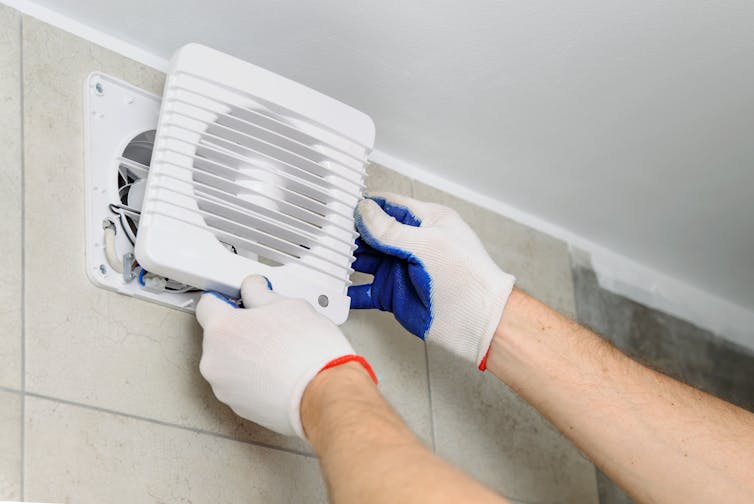Forty per cent of COVID-19 deaths in Ontario have taken place in long-term care homes. Chronic and in some cases devastating outbreaks have also been reported in shelters, detention centres and group homes for adults with disabilities. Residents and workers have died, and thousands more have been infected.
In these group facilities, termed “congregate settings” in Ontario, people eat together, and bedrooms and bathrooms are often shared. Because of this, they are very high-risk for acquiring airborne diseases.
It is imperative that congregate settings receive the best, most rigorous guidance available from Public Health Ontario (PHO). But that is not what is happening. A key aspect of infection prevention and control — indoor air quality — has been omitted from PHO’s public, written COVID-19 guidance specifically designed for these types of facilities.
Sub-standard guidance for congregate settings
Our team, which includes researchers with expertise in indoor air quality, engineering, epidemiology, public health and knowledge translation, conducted a detailed study of the public, written guidance PHO has produced specifically for institutions such as long-term care homes, shelters, group homes and correctional facilities. (The study is shared here as a pre-print, and has been submitted to a journal for peer review.)
We found no references to ventilation, HVAC (heating, ventilation and air conditioning) systems, portable air filters, bathroom exhaust fans or even opening windows. This includes PHO’s COVID-19 checklists for long-term care homes and congregate settings, which target those who are responsible for facility health and safety.
While our formal study concluded at the end of October 2021, we’ve continued to explore guidance on PHO’s website. Even as outbreaks continue in facilities such as long-term care homes and shelters, nothing much has changed, almost two years into the COVID-19 pandemic.
The precautionary principle
Crosses displayed outside a long-term care facility in Mississauga, Ont. marking the deaths residents during the COVID-19 pandemic.
THE CANADIAN PRESS/Nathan Denette
The 2003 SARS outbreak killed 44 people in Ontario. In his 2006 report for the SARS Commission, Judge Archie Campbell emphasized one central point: Ontario’s public health and health-care systems should respond to disease outbreaks using the precautionary principle.
The precautionary principle means erring on the side of caution. If you’re not sure a safety measure is necessary, take it anyway, especially if it could save lives. In particular, Campbell pleaded with decision-makers to apply the precautionary principle in the face of potential airborne transmission of a novel respiratory disease.
In 2008, PHO (then called the Ontario Agency for Health Protection and Promotion) was established, in part to ensure that Ontario would be prepared for future pandemics. PHO is mandated by provincial legislation to provide scientific and technical advice in the face of infectious disease outbreaks. It is also tasked with “evaluating the modes of transmission of febrile respiratory illnesses.”
In other words, PHO is responsible for figuring out how respiratory viruses spread, and helping the province address transmission. The legislation that created PHO also specifically tasks it with contributing “to efforts to reduce health inequities.”
Airborne transmission

Indoor air quality is a important factor in preventing airborne transmission of communicable diseases.
(Shutterstock)
Fast forward almost 15 years to the COVID-19 pandemic. Since mid-2020, physicians, scientists and engineers have been urging public health decision-makers to address airborne transmission of COVID-19. In July 2020, 239 scientists published a commentary in the journal Clinical Infectious Diseases, “advocating for the use of preventive measures to mitigate this route of airborne transmission.”
In November 2020, physicians and engineers wrote an open letter to PHO and the government of Ontario, urging them to, “update the province’s COVID-19 guidelines, regulations and public communication to reflect the importance of ventilation…”
Meanwhile, peer-reviewed evidence of airborne transmission piled up. Studies documented airborne transmission in restaurants, hospitals, hotels and churches and demonstrated that people release fine, virus-laden aerosols when they talk, sing, or simply breathe.
At the same time, scientists and engineers shared extensive information about measures with the potential to mitigate airborne transmission such as respirator-grade masks, ventilation, filtration, bathroom exhaust fans and upper-room ultraviolet disinfection.
Accountability and change

Measures with the potential to mitigate airborne transmission include respirator-grade masks, ventilation, filtration, bathroom exhaust fans and upper-room ultraviolet disinfection.
(Shutterstock)
As with responses to earlier health crises, there will likely be an inquiry into the way public health and health-care authorities in Ontario approached airborne transmission during the COVID-19 pandemic. Its recommendations may be similar to those made by the SARS Commission 15 years ago.
The difference this time? First, the scale of death. Over 12,000 people have died in Ontario, many of whom live or work in the very same congregate settings getting incomplete infection prevention and control advice from PHO.
Second, the hope that another retroactive inquiry can generate meaningful change. While we don’t discourage an inquiry, as the evidence generated by the SARS Commission is invaluable, it will not ensure accountability.
Instead, it’s time to focus on broadcasting the right information far and wide. Luckily, there are many reliable sources of guidance, including the American Society of Heating, Refrigerating and Air-Conditioning Engineers and the Clean Air Crew.
It’s also time to explore regulatory and legal mechanisms with the capacity to hold PHO accountable to its legislated mandate.
Finally, and while we attempt to mitigate the damage unfolding in real time, it’s time to seed the beginnings of a new system: one that embraces the precautionary principle, values the health and well-being of people living and working in congregate settings, and treats every single preventable death as a catastrophic failure.
This article was also co-authored by Amy Katz, a knowledge translation specialist working in the health-care system.
[ad_2]
Originally Appeared Here